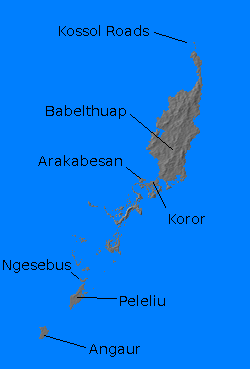![]() The Pacific War Online Encyclopedia
The Pacific War Online Encyclopedia
|
| Previous: Pai Ch'ung-hsi | Table of Contents | Next: Palawan |

The Palaus are located at west end of the Caroline Islands, some 470 miles (540 km) east of the Philippines and 600 miles (970 km) north of the western end of New Guinea. There were a total of about 100 significant islands in the group with a combined land area of 185 square miles (479 km2). There were another 100 or so small islets and exposed reefs. The larger islands are mountainous and all are jungle-clad, with mangrove swamps in some coastal areas. There is a large barrier reef off the west end of the islands that comes close ashore at Peleliu, and the eastern coasts have fringing reefs.
The islands were discovered by Europeans in 1543 and went successively through Spanish and German hands before coming under Japanese control following the First World War. By 1941, there were about 16,000 Japanese civilians here, most of whom had emigrated during the 1920s and 1930s. There were also about 6250 Melanesians, whose lot had improved sufficiently under the Japanese that they were fairly loyal to the Emperor. Over half lived on Babelthuap and most of the rest on Angaur. The Japanese population was concentrated on Koror (134.479E 7.341N), which was the civilian administrative center for the Mandates, and on the islands to the south.
In about 1918, a nonviolent nativist cult, the modekengei, made its appearance. This movement was
focused on the revitalization of Palauan culture (and, by implication,
the resistance of Japanese efforts at cultural assimilation), but it
posed no threat to Japanese control until the final few months of the
Pacific War. Nor did the movement ever spread to any of the other mandated island groups.
There are several large islands in the group, of which the largest
is
Babelthuap.
There was a large phosphate
deposit on Angaur
(producing about 110,000 tons per year during the war) and bauxite
deposits throughout the
group (producing about 94,000 tons per year). The Japanese
had built
an airfield at Peleliu
and
improved the anchorage at Kossol
Roads by the
time war broke out. The anchorage served as the mustering
point for 4
Surprise Attack Force. The Japanese also had completed a seaplane and submarine
base at Arakabesan.
The initial garrison of some 5000 naval troops was
reinforced by 14 Division (Inoue)
in May 1944. The Japanese eventually completed additional airstrips on
Ngesebus and Babelthuap and a second seaplane base at Koror.
Operation HAILSTONE. During the HAILSTONE raids of 17-18 February 1944, the
main Japanese fleet was forced out of Truk
and retreated to Palau. Because of the proximity of the islands to Hollandia, New Guinea, Pacific Fleet
launched a second series of raids on 30 March-1 April 1944 to cover MacArthur's invasion of Hollandia.
Three carrier groups
sortied from Majuro on 22 March
1943, along with two support
groups, and sailed on a roundabout course south of Truk. However, the Americans failed to avoid
detection, being sighted by a Japanese reconnaissance aircraft
on 25 March. Spruance
responded by hastening the attack timetable, ordering his destroyers to refuel from the
support group on 28 March and racing in to attack Kossol Roads two days
earlier than planned. This was not enough: Forewarned, the Japanese
fleet was again able to
make
good its escape. The Americans did sink a number of merchant ships,
and Musashi
was torpedoed and lightly damaged by Tunny. The operation was
marked by the first use of aerial mines
by carrier aircraft,
78 of which were laid by a specially trained squadron of Avengers and succeeded in
trapping over thirty merchant ships in the anchorage.
Subsidiary strikes were directed at Yap and Woleai
during this raid.
Operation STALEMATE II. The islands of Peleliu and Angaur and the anchorage at
Kossol Roads were invaded by the Allies
in September 1944 at
great cost in life. The
remainder of the Palaus were bypassed.
Climate Information:
Temperatures: Jan 80, Apr 81, Jul 81, Oct 81
Rainfall: Jan 23/11.7, Apr 21/10.4, Jul 26/15.2, Oct 22/13.1 == 135.6" per annum
References
The Pacific War Online Encyclopedia © 2007, 2009-2010, 2012 by Kent G. Budge. Index